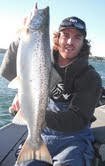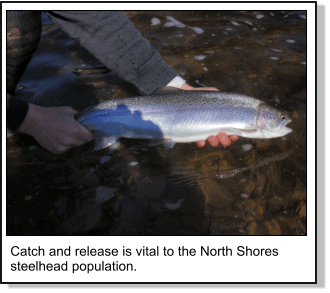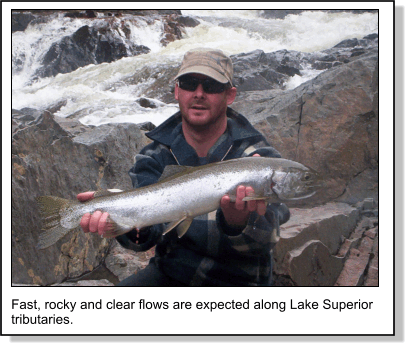|

Ontario Campgrounds
|
 Northern
Ontario’s Steelhead! Northern
Ontario’s Steelhead!
By: Tyler Dunn
Tyler Dunn Guiding
 Northern
Ontario is blessed with world class walleye,
pike, brook and lake trout fishing. The Canadian
Shield offers the perfect habitat for our lakes
to host generous populations of each species.
With so many different species available in
abundance to anglers of the north we can be
easily described as “spoiled”. Not only does the
Canadian Shield offer magnificent lakes but the
rocky rivers of Superior boost a healthy
population of hard fighting rainbow trout. For
whatever reasons it might be many local anglers
pass up the opportunity to catch migratory trout
during the spring spawning season. This leaves
huge sections of rivers relatively untouched
throughout the entire season. The following is a
few tips for bouncing and floating tributaries
on the north shore of Lake Superior. Northern
Ontario is blessed with world class walleye,
pike, brook and lake trout fishing. The Canadian
Shield offers the perfect habitat for our lakes
to host generous populations of each species.
With so many different species available in
abundance to anglers of the north we can be
easily described as “spoiled”. Not only does the
Canadian Shield offer magnificent lakes but the
rocky rivers of Superior boost a healthy
population of hard fighting rainbow trout. For
whatever reasons it might be many local anglers
pass up the opportunity to catch migratory trout
during the spring spawning season. This leaves
huge sections of rivers relatively untouched
throughout the entire season. The following is a
few tips for bouncing and floating tributaries
on the north shore of Lake Superior.
 Bouncing
Bottom Bouncing
Bottom
The northern tributaries of Lake Superior are
cold flows, rich with rock. Gravel and sandy
spawning areas can be found mixed in with the
rocks. These areas are perfect for the beginning
stages of steelhead reproduction. In both the
big and small rivers these cold, fast, clear
conditions are ideal for a bottom bouncing
angler. During early spring when water
conditions are high and murky I especially like
to bounce. I can get the bait down into the
strike zone much easier rather than with a
float. There are several options to use when
bottom bouncing but the most common setup and my
first choice is a three-way swivel with a short
two to six inch dropper line to a pencil sinker.
A two to three foot leader is then tied to the
remaining eye on the swivel. When I do plan on
bouncing bottom, I always bring 15-20 pencil
sinker with me in 1 – 1 ½ oz weight and a set of
side cutters. The side cutters are used to trim
my pencil weights to the exact size needed for a
perfect bounce. A perfect bounce isn’t
continuously slamming bottom but it is a rather
gentle tap every couple seconds. Your bait is
just kind of ticking along bottom, drifting
downstream with all the other food. Be prepared
to tie a ton of knots. Better yet, start at home
before you even go by pre-tying 8-10 inch pieces
of
monofilament to your pencil sinkers the
night before. This will save you one knot each
time you break off your sinker lead and trust me
that one less knot is nice especially on cold
days. The right length for bouncing is in the
8-10 foot range with a soft, sensitive tip and
some much needed backbone for turning fish.
Reels should have a super smooth drag with a
high line capacity for the long, fast runs a
steelhead will take. Another asset a quality
steelhead reels possess is a high gear ratio.
The high gear ratio will help you catch up to a
hot fish that changes direction several times at
high speed. A Shimano Stradic Fi in the 2500 or
3000 size is a great choice for bouncing and
pairs up nice on almost any rod. Bouncing bottom
is definitely an art form. It takes a ton of
practice but once you get the “feel” down
steelhead don’t stand a chance. Superior
steelhead are suckers for bounced roe, flies,
worms and several artificial baits.
 Floating Floating
Probably the most common way to hook a steelhead
throughout southern Ontario is under a float.
Northern Ontario isn’t much different in that
aspect although the centerpin phenomenon hasn’t
quiet caught on up here in the north. Most
anglers still opt to float with a spinning reel.
I imagine that will change soon enough. When
targeting steelhead with a float on Superior’s
tributaries you always have to remember one
thing before you begin. You have time. It isn’t
uncommon to have nice, long sections of river
all to yourself for a few hours, a half day and
often times the entire day. Don’t rush yourself
and try to stay away from running and gunnings
especially if you’re from out of town and
unfamiliar with the area. If you find yourself
fishing a good looking area, stick it out. More
often than not there are fish around. 10-13 foot
rods excel on the northern tributaries with some
rivers allowing rods up to 15 feet to be used.
Raven tackle offers an amazing line up of rods
that are reasonably priced and backed with a
great warranty and customer service. Ravens new
RV9 float rod is extremely light and is the
perfect match for the Superiors flows along
Highway 17. The RV9 also has enough power to
tackle fish in flows such as the Soo’s rapids
where big steelhead and even Atlantic salmon can
be taken. An 8-10 pound mainline attached to a
leader that is anywhere from 4-8 pounds is more
than sufficient. Most of the rivers running into
Superior are glacier cold, gin clear flows.
There are a few exceptions but for the most part
northern steel headers are plagued with clear
water conditions. What is the remedy? Light
fluorocarbon with a longer lead and some much
needed patience. I like to run my leads with 8
pound fluorocarbon as much as I can but I
continue to find myself regularly dropping to
4-5 pound for finicky fish.
Ontario’s spin and float anglers have the
pristine waters of Lake Superior at their
fingertips. The TransCanada Highway 17 runs
along the shore of Superior and is an absolute
hotspot for steelhead from Sault Ste. Marie all
the way up to Thunder Bay. Almost all rivers
with some water, host a population of steelhead
looking to spawn each spring. Take an adventure
north to Superiors tributaries and take
advantage of one of Ontario’s best kept secrets.
|